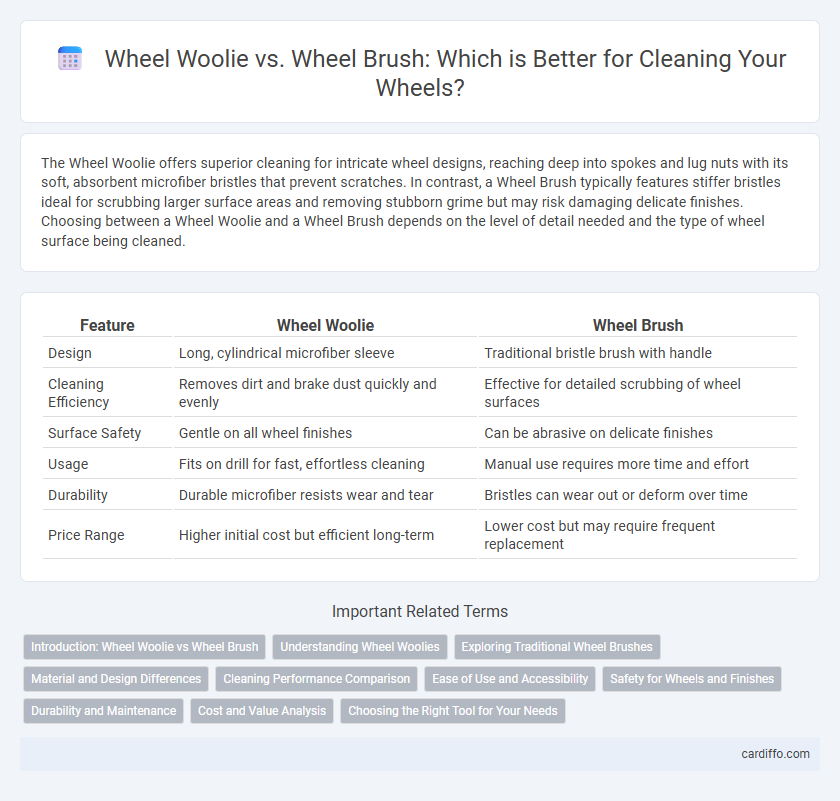The Wheel Woolie offers superior cleaning for intricate wheel designs, reaching deep into spokes and lug nuts with its soft, absorbent microfiber bristles that prevent scratches. In contrast, a Wheel Brush typically features stiffer bristles ideal for scrubbing larger surface areas and removing stubborn grime but may risk damaging delicate finishes. Choosing between a Wheel Woolie and a Wheel Brush depends on the level of detail needed and the type of wheel surface being cleaned.
Table of Comparison
| Feature | Wheel Woolie | Wheel Brush |
|---|---|---|
| Design | Long, cylindrical microfiber sleeve | Traditional bristle brush with handle |
| Cleaning Efficiency | Removes dirt and brake dust quickly and evenly | Effective for detailed scrubbing of wheel surfaces |
| Surface Safety | Gentle on all wheel finishes | Can be abrasive on delicate finishes |
| Usage | Fits on drill for fast, effortless cleaning | Manual use requires more time and effort |
| Durability | Durable microfiber resists wear and tear | Bristles can wear out or deform over time |
| Price Range | Higher initial cost but efficient long-term | Lower cost but may require frequent replacement |
Introduction: Wheel Woolie vs Wheel Brush
Wheel Woolies and wheel brushes are essential tools for thorough automotive wheel cleaning, each designed to target different surfaces and grime levels. Wheel Woolies feature soft, durable microfiber sleeves that conform to intricate wheel spokes, effectively removing brake dust without scratching delicate finishes. Wheel brushes, typically made with stiff bristles, excel at scrubbing tougher dirt and reaching narrow crevices, providing a comprehensive cleaning solution for various wheel types.
Understanding Wheel Woolies
Wheel Woolies feature thick, soft microfiber strands designed to envelop and clean intricate wheel surfaces gently, reducing the risk of scratches on delicate finishes. Unlike traditional wheel brushes, Wheel Woolies can reach tight spaces and crevices, effectively removing brake dust and grime without harsh abrasion. Their flexible construction makes them ideal for deep cleaning alloy and multi-spoke wheels, maintaining both appearance and material integrity.
Exploring Traditional Wheel Brushes
Traditional wheel brushes offer precise cleaning for intricate wheel designs, effectively removing brake dust and grime from tight spaces. Wheel woolies, made with soft microfiber strands, provide gentle yet thorough cleaning for delicate finishes, minimizing the risk of scratches. Comparing both, traditional wheel brushes excel in durability and scrubbing power, while wheel woolies prioritize surface protection and detail care.
Material and Design Differences
Wheel Woolies feature soft, dense microfiber bristles designed to conform to intricate wheel surfaces, effectively capturing dirt without scratching. Wheel brushes typically use stiffer nylon bristles arranged in a fixed, brush-like design to provide more aggressive scrubbing power on stubborn grime and brake dust. The microfiber construction of Wheel Woolies offers superior flexibility and gentleness, while wheel brushes prioritize durability and abrasion resistance through their rigid synthetic fibers.
Cleaning Performance Comparison
Wheel Woolies provide superior cleaning performance by reaching tight spaces and removing tough grime with their soft, dense bristles that conform to wheel contours. Wheel brushes offer more aggressive scrubbing power for heavily soiled wheels but may risk scratching delicate finishes if not used carefully. For detailed cleaning with minimal damage, Wheel Woolies deliver a more efficient and gentle solution compared to traditional wheel brushes.
Ease of Use and Accessibility
Wheel woolies offer superior ease of use with their flexible, extendable handles that reach tight spaces without requiring excessive effort. Wheel brushes, while effective, often have rigid, shorter handles that can make accessing deep wheel crevices more challenging for users. Woolies provide better accessibility on multi-spoke and intricate wheel designs, enhancing cleaning efficiency for both beginners and professionals.
Safety for Wheels and Finishes
Wheel woolies offer a safer option for cleaning wheels and finishes due to their soft microfiber bristles that minimize the risk of scratches and swirl marks. In contrast, wheel brushes, especially those with stiff or metal bristles, can cause damage to delicate finishes and paintwork if not used carefully. Choosing a wheel woolie enhances protection for sensitive wheel surfaces while effectively removing brake dust and grime.
Durability and Maintenance
Wheel woolies offer superior durability with synthetic fibers designed to resist wear and tear, maintaining effectiveness over extended use. Wheel brushes, often made with nylon or natural bristles, may degrade faster and require more frequent replacement due to bristle fraying and breakage. Maintenance of wheel woolies is simpler as they can be rinsed and dried easily without losing shape, whereas wheel brushes need careful cleaning to prevent buildup and bristle damage.
Cost and Value Analysis
The Wheel Woolie offers cost-effective durability with microfiber strands that provide gentle yet effective cleaning, ideal for frequent detailing without frequent replacements. In contrast, the Wheel Brush typically has a lower upfront cost but may wear out faster and risk scratching delicate wheels, potentially increasing long-term expenses. Evaluating overall value, the Wheel Woolie balances price and performance for thorough, safe cleaning, making it a more economical choice for consistent maintenance.
Choosing the Right Tool for Your Needs
Wheel woolies provide superior coverage and gentle cleaning for delicate alloy wheels, making them ideal for intricate designs and frequent use. Wheel brushes offer firmer bristles suited for tougher grime and brake dust, excelling on durable steel or heavily soiled wheels. Selecting the right tool depends on wheel material, level of dirt buildup, and the desired cleaning precision.
Wheel woolie vs Wheel brush Infographic

 cardiffo.com
cardiffo.com